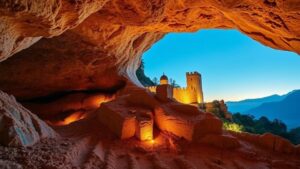Examining connections between ancient myths and physical structures in Peru.
Examining Connections Between Ancient Myths and Physical Structures in Peru
Peru, a land rich in history and cultural heritage, is renowned for its remarkable physical structures, many of which are deeply intertwined with ancient myths. These connections not only offer insights into the indigenous worldview but also provide a deeper appreciation of Peru’s architectural feats. This article delves into some of the most notable structures and the myths that accompany them.
The Nazca Lines
The Nazca Lines, located in the Nazca Desert of southern Peru, date back to around 500 BCE to 500 CE. e massive geoglyphs, which can be seen only from the air, depict various figures ranging from simple lines to complex shapes, including animals and human-like figures. The most famous of these is the hummingbird, encompassing an area of over 1,200 feet.
Mythologically, the Nazca people believed that these designs were not simply artistic expressions but served as pathways for rituals directed towards the gods. Some scholars argue that these lines were a form of astronomical calendar. For example, they allegedly align with celestial events, indicating agricultural cycles relevant to the Nazca civilizations survival.
- The hummingbird geoglyph is thought to be a tribute to deities associated with fertility and water.
- Archaeologists suggest that the lines could have been part of religious ceremonies aimed at invoking rain and bounty.
Macchu Picchu: The Lost City of the Incas
Built in the 15th century under the reign of Emperor Pachacuti, Machu Picchu is one of the most iconic geographical and archaeological sites in the world. Nestled high in the Andes Mountains, this site has been associated with various legends, including the story of its creation as a royal retreat and religious sanctuary.
The Inca mythology surrounding Machu Picchu posits that the site was a sacred place dedicated to the worship of the sun, represented by the sun god Inti. The Intihuatana stone, often referred to as the hitching post of the sun, is believed to have been used in religious rituals tied to solar alignments. During the annual solstices, sunlight strikes the stone at a particular angle, accentuating its significance.
- Machu Picchus agricultural terraces were designed with precision, reflecting the Incas advanced understanding of hydrology and astronomy.
- The site remains a pilgrimage destination, symbolizing the enduring connection between physical structures and spiritual beliefs.
Tiwanaku: An Ancient Metropolis
The Tiwanaku culture, which flourished from approximately 500 to 1000 CE near Lake Titicaca, is marked by its grand architectural achievements and intricate mythological beliefs. The site features massive stone constructions, such as the Akapana Pyramid and the Gateway of the Sun, which are rich in astronomical symbolism.
The Gateway of the Sun, crafted from a single piece of Andesite stone, contains carvings of what many interpret to be the sun god and other deities. This aligns with local legends suggesting that it was a portal for the gods to descend to the earth, linking the terrestrial realm with the divine.
- Tiwanaku is considered an ancestor to the Inca civilization in both culture and construction techniques.
- The site has been linked to agricultural practices, with myths suggesting that offerings at these structures would ensure good harvests.
The Role of Myth in Modern Peruvian Culture
The influence of these ancient myths persists in contemporary Peruvian culture. Many local traditions, festivals, and rituals continue to reflect ancient beliefs tied to these physical structures. For example, during Inti Raymi, the Festival of the Sun celebrated in Cusco, participants reenact ancient rituals honoring Inti, showcasing a direct link back to Incan spirituality and architecture.
Plus, the preservation of these sites has become a focal point in Peru’s efforts to promote cultural heritage and tourism. Organizations are increasingly recognizing the value of merging mythological understanding with historical conservation efforts. This approach enriches the narrative surrounding these ancient landmarks, drawing tourists eager to explore their mythic significance.
Actionable Takeaways
Understanding the connections between ancient myths and physical structures in Peru enhances our appreciation not just of architecture but of the cultural narrative that continues to resonate today. Here are some actionable takeaways:
- When visiting South America, particularly Peru, take the time to explore these sites with local guides who provide insights into the mythological contexts.
- Consider the historical significance of preservation efforts in maintaining the cultural heritage associated with these structures.
- Engage with local communities to learn about how ancient beliefs continue to influence modern practices and celebrations.
To wrap up, the connections between ancient myths and physical structures in Peru reflect a profound legacy that shapes contemporary cultural identity. By exploring these connections, we gain a greater understanding of how the past is interwoven with the present, enriching our global tapestry of shared human experience.



